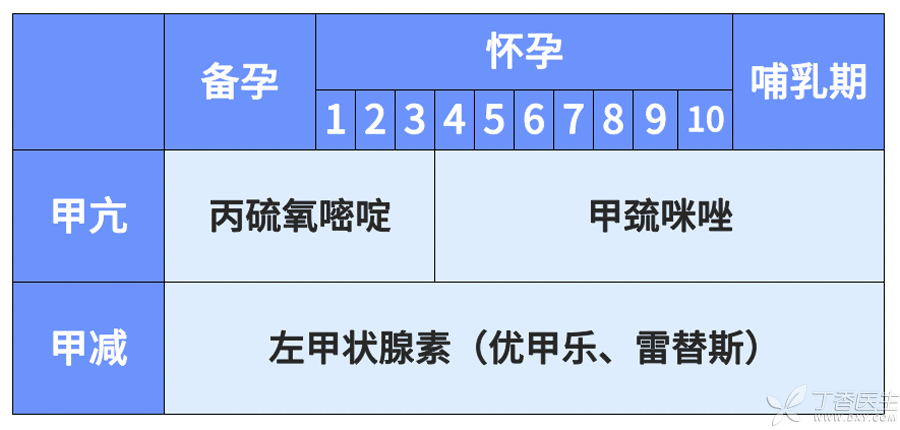
Whether we like it or not, thyroid diseases such as hyperthyroidism or hypothyroidism prefer women.
Ordinary women are depressed when they get a disease, not to mention these young women aged 20-40, who often have reproductive requirements.
Can you be pregnant with hyperthyroidism or hypothyroidism?
If you need to take medicine, will it affect pregnancy?
Can you still nurse normally after delivery?
… …
On the issue of having children, there will always be a series of problems.
Today we will talk about this topic together. Before we start talking, we will first explain two problems.
-
The hyperthyroidism mentioned in this article refers to Graves disease hyperthyroidism, which is the most common cause of hyperthyroidism. More than 85% of hyperthyroidism is caused by this.
-
Hypothyroidism refers to hypothyroidism caused by thyroid itself, including Hashimoto’s thyroiditis, iodine 131 or hypothyroidism caused by thyroid surgery for hyperthyroidism.
First, can I be pregnant?
It is not easy to answer the question of whether women with hyperthyroidism or hypothyroidism can become pregnant. After all, everyone’s situation is different and may involve all aspects of problems.
We will simplify the problem here, assuming other conditions permit, and only consider the situation of hyperthyroidism or hypothyroidism that does not cause any serious complications being treated with drugs during this special period.
1. Good prenatal and postnatal care
First of all, we must make it clear that thyroid diseases are closely related to pregnancy and eugenics.
Hypothyroidism during pregnancy will increase the risks of premature delivery, abortion, low birth weight, stillbirth and pregnancy hypertension, and will also affect the neurointellectual development of the fetus.
Poor control of thyrotoxicosis during pregnancy (which can be manifested as hyperthyroidism) is related to abortion, pregnancy hypertension, premature delivery, low birth weight infants, intrauterine growth restriction, stillbirth, etc.
2. Eat or Eat
Therefore, women with hyperthyroidism or hypothyroidism should be treated when they are treated, and drugs should be used when they are used.
Don’t only consider that drugs may have adverse effects on babies, but also fully understand that if they are not treated, the risks to babies may be greater.
3. How to eat, there is a lot of attention
Generally speaking, it is relatively safe to use drugs and review them regularly under the guidance of specialists in regular hospitals, and the advantages outweigh the disadvantages.
Second, how to start preparing for pregnancy?
Hyperthyroidism
Women with Graves’ disease plan to become pregnant. If they are treated with drugs, they need to stop methimazole and use propylthiouracil instead. It is best to consider pregnancy after thyroid function is controlled to normal.
Hypothyroidism
Women with a history of hypothyroidism plan pregnancy and need to use levothyroxine therapy to restore the thyroid hormone level to normal and to conceive after TSH < 2.5 mIU/L (0.1 ~ 2.5 mIU/L). The ideal goal is to reach 0.1 ~ 1.5 mIU/L.
Note: It is not simply to see that TSH is normal.
Second, there are matters needing attention in what after pregnancy?
Hyperthyroidism
1. Which drug to choose during pregnancy?
The commonly used anti-methylthiazole drugs are methimazole and propylthiouracil. Although methimazole and propylthiouracil may be risky to mothers and babies, they must have more advantages than disadvantages for pregnant women with hyperthyroidism who must be treated. Therefore, propylthiouracil can continue to be used for 1-12 weeks of pregnancy (early pregnancy) to avoid malformation caused by methimazole. However, in order to avoid the possible hepatotoxicity of propylthiouracil, methimazole should be used.
In addition to these two drugs used to treat hyperthyroidism, there is also a kind of drug commonly used to treat hypermetabolic symptoms caused by hyperthyroidism-adrenaline receptor blocker, propranolol. However, long-term treatment of such drugs may be unfavorable to babies. Specialists should weigh the pros and cons and avoid long-term use.
During pregnancy, methimazole or propylthiouracil are generally not used at the same time (although this method may be used in the treatment of hyperthyroidism in ordinary people), because this may lead to hypothyroidism in the fetus.
2. Examination during pregnancy is different
In the process of pregnancy monitoring hyperthyroidism control index FT4 is the first choice, as long as FT4 is close to or slightly higher than the upper limit of the reference value, even if TSH is very low. In short, it is OK to check thyroid function during pregnancy as long as FT4 is normal or slightly elevated, and do not tangle too much with significantly reduced TSH, which has little impact on the baby.
3. Hyperthyroidism changes a lot during pregnancy,
Generally speaking, hyperthyroidism may worsen in early pregnancy, but the dosage can be reduced in the middle and late stages, and about 20% ~ 30% of patients may stop taking drugs.
Therefore, thyroid function needs to be regularly reviewed under the guidance of specialists during the whole pregnancy, the dosage of drugs should be adjusted according to the results, and the index should be controlled with the minimum dosage as far as possible. If conditions permit, the drug can be stopped for observation in the middle and late pregnancy.
Hypothyroidism
During pregnancy, the maternal and fetal demand for thyroid hormones increases. Healthy pregnant women can increase the production and secretion of endogenous thyroid hormones through self-regulation. However, for pregnant women with hypothyroidism, only levothyroxine can be supplemented to meet the pregnancy demand.
Levothyroxine is not easy to pass through the placenta, has no toxic effect on the fetus, does not cause malformation, and is as safe as vitamins (such as folic acid). Levothyroxine plays an important role in the development of infants’ central nervous system. Therefore, it is not only necessary to continue to use during pregnancy, but also needs to increase the dosage by about 25% ~ 30%.
It is worth noting that the control objectives of hypothyroidism TSH during pregnancy are different in different pregnancies:
- 0.1 ~ 2.5 mIU/L at 1 ~ 12 weeks of gestation; 0.2 ~ 3.0 mIU/L at 13 ~ 27 weeks of gestation; 0.3 ~ 3.0 mIU/L at 28 ~ 40 weeks of gestation.
Regular review is required under the guidance of specialists throughout pregnancy, and the dosage of drugs should be adjusted at any time according to the results of thyroid function.
Three, postpartum can breast feeding?
Hyperthyroidism
Hyperthyroidism may worsen after childbirth, and women who stop taking drugs in the middle and late stages of pregnancy may need to take drugs again and pay attention to timely reexamination of thyroid function. One month after delivery, the drug dose needs to be readjusted according to the results of thyroid function, and regular reexamination is still needed thereafter.
It is safe to take appropriate amount of drugs to treat hyperthyroidism during lactation. Generally, methimazole is the first choice, 20 ~ 30 mg per day is safe. Propylthiouracil is also safe at 300 mg per day as a secondary option.
Drugs should be taken in batches after lactation. That is to say, you can take the medicine immediately after feeding the milk. If possible, the time between taking the medicine this time and the next feeding can be appropriately longer, which can minimize the dosage of the medicine entering the baby’s body through milk, reduce possible side effects, and regularly monitor the baby’s thyroid function when necessary.
Hypothyroidism
The increased demand for thyroid hormone during pregnancy is caused by pregnancy itself. Therefore, the dose of levothyroxine after delivery should be reduced accordingly, but it is still necessary to continue taking it, and the thyroid function adjustment dose should be reviewed 6 weeks after delivery.
Breastfeeding is completely unaffected.
Summary
Having said so much, the following is a summary:
1. No matter hyperthyroidism or hypothyroidism, if you need treatment, you must treat it. It is relatively safe to use drugs under the guidance of specialists. Women with hyperthyroidism or hypothyroidism need to plan pregnancy after the thyroid index reaches the standard.
2. Compared with hypothyroidism, the drugs for hyperthyroidism treatment are slightly different during pregnancy preparation, pregnancy and lactation. The following picture can help you remember.

3. Once pregnant, timely reexamination of thyroid function is necessary, in the whole pregnancy and lactation also need to adjust the dosage of drugs at any time according to the results of thyroid function. Generally speaking, drugs for hyperthyroidism need to be reduced during pregnancy and increased after delivery, while hypothyroidism is the opposite.
Hyperthyroidism or hypothyroidism is a very common disease among women. As long as regular treatment is carried out, medication is safe even during pregnancy. Only in this way can possible adverse effects be avoided, a healthy baby be born, and normal breast feeding be carried out.
